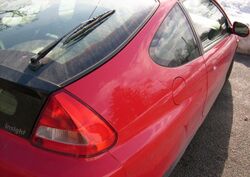Super ultra-low emission vehicle
Topic: Engineering
 From HandWiki - Reading time: 4 min
From HandWiki - Reading time: 4 min
Super ultra-low emissions vehicle (SULEV) is a U.S. classification for passenger vehicle emissions. The classification is based on producing 90% fewer emissions than the average gasoline-powered vehicle.[1] The SULEV standard is stricter than the standard for LEV (low emission vehicle) and ULEV (ultra-low-emission vehicle), however not as strict as PZEV (partial zero-emissions vehicle) which meets the SULEV standard for tailpipe emissions, but has zero instead of reduced evaporative emissions.[2] Japan also offers an SU-LEV classification, for vehicles that show a 75 percent reduction in emissions vis-à-vis the 2005 emissions standards.
Examples
Examples of vehicles delivering SULEV emissions performance include:
- Honda Accord 2000-?[3]
- Honda Insight (CVT transmission models only)[4]
- Honda Civic Hybrid CVT transmission models only, AT-PZEV available in certain states[5]
- Honda Civic GX Natural Gas
- Honda CR-Z (AT-PZEV)
- Toyota Prius[1]
- Ford Focus SULEV[6]
- BMW SULEV i3 REx, 128i, 328i, 325i, 325Ci, and 325iT[7]
- Subaru PZEV Vehicles beginning with 2008 year models including Forester, Outback, Impreza and Legacy[8]
- Chevrolet Volt[9]
- Hyundai Elantra[10]
- Lexus CT200h
- Honda Clarity PHEV 2018 - LEV3-SULEV20
- Kia Forte
- Volkswagen Jetta[11]
- Mini Cooper Hardtop 4-Door[12]
- Toyota RAV4 Hybrid[13]
- Pontiac Grand Prix, 3800 V6 equipped vehicles beginning with the 2005 model year
- Toyota Highlander Hybrid[14]
- Chrysler Pacifica Hybrid[15]
- Volvo S80 PZEV[16]
Tax incentives
In California, manufacturers of SULEVs can be given a partial credit for producing a zero-emission vehicle (ZEV) and so a vehicle of this type can be administratively designated as a partial zero-emissions vehicle (PZEV). In order to qualify as a PZEV, a vehicle must meet the SULEV standard and, in addition, have zero evaporative emissions from its fuel system plus a 15-year/150,000 mi (241,402 km) warranty on its emission-control components.
In the case of hybrid vehicles this warranty is extended to the electric propulsion components (electric motor/generator/starter, battery, inverter, controls) and their mechanical interface to the driveline. However, the high-voltage battery warranty is limited to ten years (but still 150,000 miles).
See California AB 1493 [1].
See also
- Engineering:California Air Resources Board – Clean air agency in California, USA
- Engineering:Ultra-low-emission vehicle
- Engineering:Partial zero-emissions vehicle
References
- ↑ 1.0 1.1 "What is a Super Ultra Low Emissions Vehicle?". http://alternativefuels.about.com/od/glossary/g/SULEV.htm.
- ↑ "Culture". https://www.cnet.com/culture/. Retrieved 30 July 2023.
- ↑ "404". http://www.honda.com/newsandviews/article.aspx?id=280-en.
- ↑ "InsightCentral.net - Knowledge Base - Honda Insight Emissions Standards". http://www.insightcentral.net/KB/compare/emissions.html.
- ↑ "Honda Worldwide | World News | News Releases | June 12, 2003". http://world.honda.com/news/2003/4030612.html.
- ↑ Focus Specifications ford.com [|permanent dead link|dead link}}]
- ↑ "HowStuffWorks - Learn How Everything Works!". http://consumerguideauto.howstuffworks.com/2011-bmw-3-series-4dr-sdn-328i-xdrive-awd-sulev.htm.
- ↑ "It's What Makes a Subaru, a Subaru: Controlling Emissions - Part Two". http://drive2.subaru.com/Fall08/Fall08_whatmakes.htm.
- ↑ "Chevy Volt gets a Low Emissions Package for California; HOV lanes access". http://www.greencarcongress.com/2011/11/volt-20111117.html.
- ↑ "New Car Reviews, Recalls and Sales: Sedans, SUVs and More". https://www.goodhousekeeping.com/travel-products/car-reviews/.
- ↑ "2021 Jetta from Volkswagen". http://www.vw.com/models/jetta/.
- ↑ "2016 MINI Cooper Hardtop 4 Door Pricing, Specs & Reviews | J.D. Power Cars". http://www.jdpower.com/cars/MINI/Cooper%20Hardtop%204%20Door/2016.
- ↑ "2016 Toyota RAV4 Hybrid Product Information | Toyota". http://toyotanews.pressroom.toyota.com/releases/2016+rav4+hybrid+product+specs.htm.
- ↑ "3 Things You Didn't Know About the 2018 Highlander Hybrid" (in en). 24 May 2018. https://www.smarttoyota.com/blogs/2398/toyota-vehicles/about-the-2018-highlander-hybrid/.
- ↑ "Eligible Vehicles - Single Occupant Carpool Lane Use Stickers". https://www.arb.ca.gov/msprog/carpool/not-valid-list-carpool-2018-archive.htm.
- ↑ "Volvo S80 Owner's Manual". https://volvornt.harte-hanks.com/manuals/2010/2010_S80/2010S80OwnersManual.pdf.
External links
- "University of California, Riverside Study Shows Accelerated Introduction of Super-Clean Cars Will Help Los Angeles Meet Federal Smog Standards by 2010" (Press release). University of California, Riverside. 23 September 2003. Retrieved 10 July 2011.
- "Climate Change Program". California Environmental Protection Agency. http://www.arb.ca.gov/cc/cc.htm. Retrieved 10 July 2011.
- "Los Angeles Green Vehicle List for Smog & Green House Gas Reductions - Updated December 2011". http://www.ladot.lacity.org/pdf/PDF225.pdf. Retrieved 5 January 2012.
 |
 KSF
KSF
